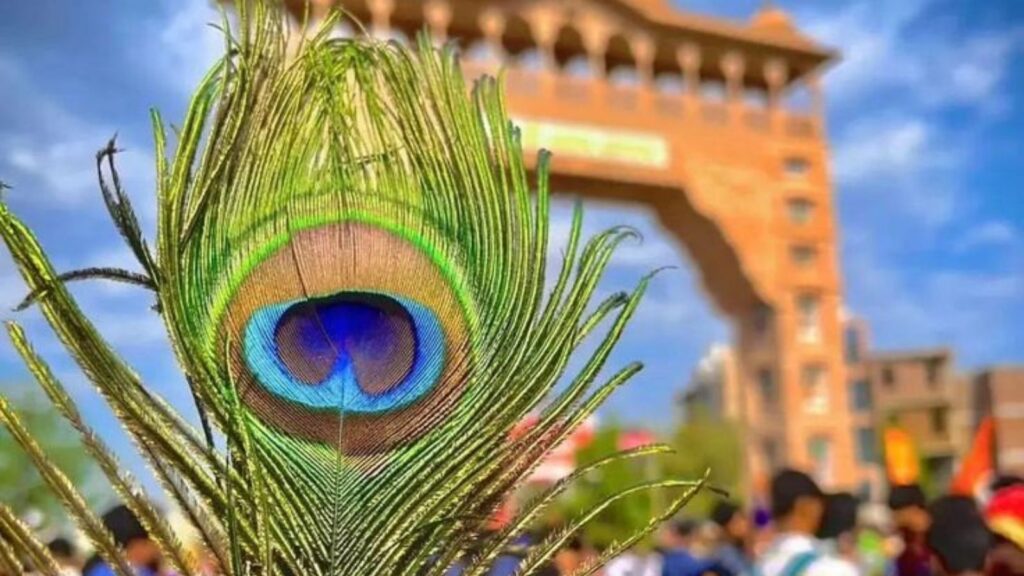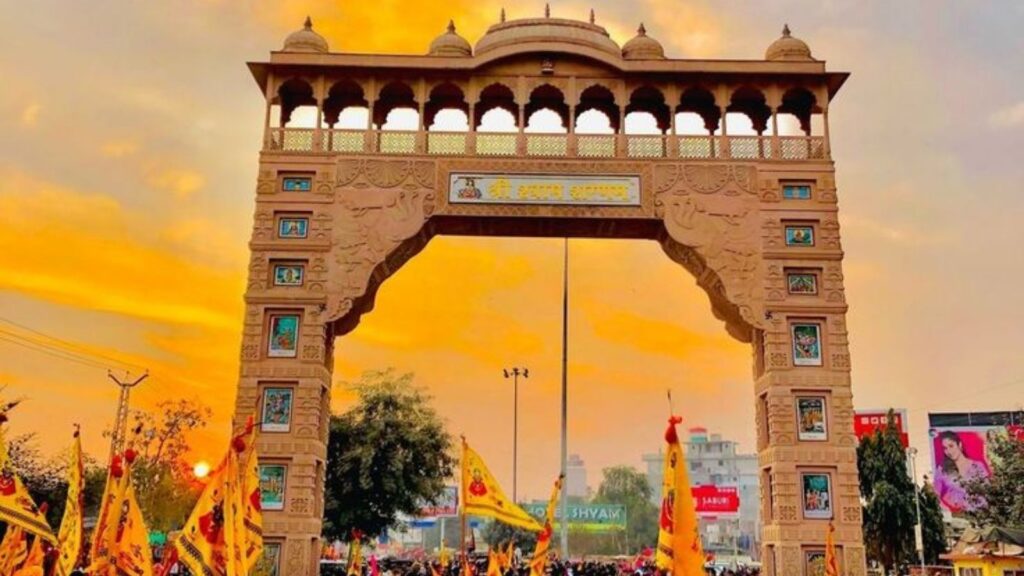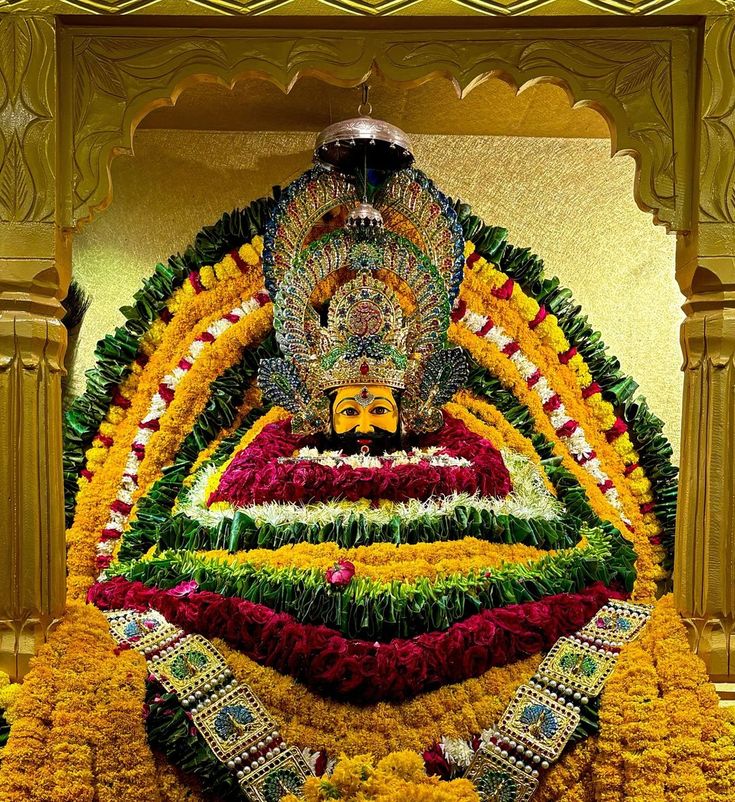Did you ever sit spellbound, listening to tales of Khatu Shyam’s divine blessings, shared with awe and devotion? They say the moment you step into the sacred land of Khatu in Rajasthan, an unexplainable peace washes over you, as if Shyam Baba himself welcomes you. Countless stories echo of lives transformed, prayers answered, and faith rewarded—often without the need for words, only a pure heart. But who is this extraordinary soul revered as the “God of Kali Yuga,” whose promise to help devotees resonates even today? What is the story of his unmatched sacrifice and his transformation into Khatu Shyam, the beloved guardian of hope, who continues to illuminate countless lives with miracles and blessings?
Who was Khatu Shyam Babaji?

Khatu Shyam, the beloved deity of millions, was not always known by this divine name. He was originally called Barbarik, the valiant grandson of Bhima, one of the mighty Pandavas, and the son of Ghatotkacha and Maurvi. From the moment of his birth, Barbarik displayed unparalleled strength, courage, and unwavering devotion to the path of dharma. His remarkable abilities in warfare, combined with his steadfast commitment to righteousness, laid the foundation for his transformation into Khatu Shyam, the savior of devotees and the eternal symbol of hope and faith in Hindu mythology.
Story of Khatu Shyam Baba

The tale of Khatu Shyam Baba begins with the valiant warrior Barbarik, known for his unwavering devotion to Goddess Maa. Impressed by his intense penance and devotion, the Goddess blessed him with three divine arrows, each capable of destroying the world. These arrows symbolized his unmatched strength and mastery in battle.
As the epic Mahabharata war drew near, Barbarik, eager to join the fray, sought his mother Hidimba’s blessing. Wise and discerning, Hidimba warned him that his vow to support the weaker side might lead him to fight against the Pandavas, as the Kaurava army vastly outnumbered them. With this counsel, Barbarik set out for the battlefield, prepared to honor his promise of protecting the weak.
However, Lord Krishna, knowing the Pandavas were destined to triumph, decided to intervene. Disguised as a humble Brahmin, Krishna approached Barbarik to test his resolve and prevent unintended consequences. This meeting marked the beginning of an extraordinary turn of events where Barbarik’s devotion and selflessness would lead him to make the ultimate sacrifice, securing his place as Khatu Shyam, the eternal symbol of hope, faith, and miracles.
The Great Sacrifice of Barbarika
To maintain the balance in the Mahabharata war and prevent unnecessary destruction, Lord Krishna asked Barbarik for an extraordinary sacrifice: his own head! Being divine, Krishna knew that the Pandavas were destined to win, but he wanted their victory to come through righteousness, not sheer power.
Barbarik, ever devoted to dharma, didn’t hesitate for even a moment. He agreed to the ultimate sacrifice, demonstrating his unwavering faith and selflessness. However, before surrendering his head, Barbarik made a heartfelt request: he wished for his head to be placed on a hill so he could witness the entire battle. Moved by his devotion, Krishna granted his wish, allowing him to observe the Kurukshetra war as a silent yet powerful presence.
Though he couldn’t participate in the battle, Barbarik’s sacrifice became a symbol of true heroism and devotion. His severed head on the hill stood as a testament to selflessness and the greater good. Barbarik’s story reminds us that the greatest victories in life often come from acts of sacrifice and compassion, proving that real strength lies in putting others before oneself.
Suggested Read :- Celebrate New Year 2025 In Rajasthan
The Promise of Lord Krishna
Before accepting the sacrifice, Krishna promised Barbarika immortality and assured him that anyone who came to him would have their wishes fulfilled. This promise transformed Barbarika into Khatu Shyam, a divine figure destined to guide and protect his devotees. This divine transformation ultimately gave birth to the “Khatu Shyam Mandir,” a sacred place where millions flock to seek blessings and express their devotion.
Why Millions Believe in His Power

The Khatu Shyam temple in Rajasthan draws pilgrims from across the globe, with many devotees sharing stories of how their prayers were answered and how they felt a profound connection with the divine presence of Khatu Shyam Baba. Today, Khatu Shyam is revered as a symbol of hope, unwavering devotion, and selfless sacrifice. Visitors to the temple come with faith, confident that their prayers will be heard, no matter how softly they are uttered. The temple’s rich legacy is filled with miraculous tales of wishes fulfilled, strengthening the belief that Khatu Shyam holds the key to their destinies.
Over time, the story of Khatu Shyam Ji continues to inspire and uplift countless souls, reminding them of the transformative power of faith, sacrifice, and the importance of offering help and kindness to others during their struggles.
Khatu Shyam Temple in Rajasthan
The Khatu Shyam Temple, located in Khatu, Rajasthan, is a prominent Hindu shrine dedicated to Lord Krishna in his form as Shyam Baba. This sacred temple attracts devotees from all over, especially those seeking blessings for love, marriage, and relationships.
The deity of the temple, Shyam Baba, is uniquely portrayed as a youthful Krishna with a moustache, a representation that distinguishes him from other traditional depictions of the god. Devotees believe that Shyam Baba’s divine compassion extends particularly to those seeking guidance and blessings for matters of the heart.
Khatu Shyam Mandir is a lively and vibrant place of worship, especially during its grand festivals. The temple hosts numerous celebrations throughout the year, with the most significant being the Khatu Shyam Fair. This annual event is a spectacular blend of religious rituals, cultural performances, and joyful festivities, drawing thousands of visitors and creating an atmosphere filled with devotion and celebration.
How to Reach Khatu Shyam in Rajasthan
By Road
- From Jaipur: Khatu Shyam Ji temple is about 80 kilometres from Jaipur. You can drive or take a taxi via NH11, which takes approximately 2-3 hours.
- From Delhi: The distance is around 270 kilometres. You can either drive or take a bus to reach Khatu Shyam. Regular buses run from Delhi to Sikar, and from there, you can hire a taxi to Khatu.
- Local Transport: Once in Khatu, auto-rickshaws and local taxis are available to take you to the temple.
By Train
- Nearest Railway Station: The nearest railway station is Sikar Junction, located about 20 kilometres from Khatu Shyam Ji temple.
- From Major Cities: Trains from cities like Jaipur, Delhi, and Jodhpur regularly run to Sikar. Once you arrive at Sikar, you can take a taxi or auto-rickshaw to the temple.
By Air
- Nearest Airport: Jaipur International Airport is the closest airport, situated around 85 kilometres from Khatu Shyam.
- Flights: Jaipur is well connected with major cities in India. From the airport, you can hire a taxi or use ride-sharing apps to reach Khatu Shyam.
Timings for Khatu Shyam Temple
The Khatu Shyam Temple is open throughout the year with the following timings:
- Morning: 5:00 AM to 12:00 PM
- Evening: 4:00 PM to 9:00 PM
Best Time to Visit Khatu Shyam in Rajasthan
The best time to visit Khatu Shyam Ji Mandir in Rajasthan is during the annual Khatu Shyam Fair. This grand event usually takes place in the spring, between February and March. The fair is a vibrant and colorful celebration, drawing thousands of devotees from all over India to seek blessings and participate in the lively festivities.
Frequently Asked Questions (FAQS)
Q: Is Khatu Shyam mentioned in the Mahabharata?
A: Khatu Shyam, originally known as Barbarik, is indirectly mentioned in the Mahabharata, though his story is not detailed in the epic. He is a significant figure tied to the battle of Kurukshetra.
Q: What is the myth of Khatu Shyam?
A: The myth of Khatu Shyam revolves around Barbarik, a warrior who sacrificed his head to Lord Krishna to maintain the balance of the battle in the Mahabharata. He later transformed into Khatu Shyam, a deity who grants blessings to his devotees.
Q: What is the mystery of Khatu Shyam?
A: The mystery of Khatu Shyam lies in his divine transformation from Barbarik, a warrior who made a selfless sacrifice, to a deity who listens to the prayers of his devotees and fulfills their wishes.
Q: Where is the real face of Khatu Shyam Ji?
A: The real face of Khatu Shyam Ji is believed to be hidden, with only a symbolic representation of his image seen at the Khatu Shyam Mandir in Rajasthan.
Q: Whose son was Barbarik?
A: Barbarik was the son of Ghatotkacha (son of Bhima, one of the Pandavas) and Maurvi.
Q: Is Khatu Shyam Ji an avatar of Vishnu?
A: Yes, Khatu Shyam Ji is believed to be an incarnation of Lord Krishna, who appeared in the form of Shyam Baba to guide and protect his devotees.







